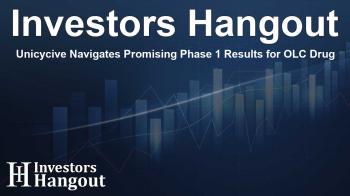Unicycive Navigates Promising Phase 1 Results for OLC Drug

Unicycive's Breakthrough in Kidney Therapeutics
Unicycive Therapeutics, Inc. (NASDAQ: UNCY) has made headlines with the release of positive results from a Phase 1 study of oxylanthanum carbonate (OLC). This innovative drug aims to help patients suffering from hyperphosphatemia, a condition often linked to chronic kidney disease. With their current market capitalization around $79 million, Unicycive is showing impressive financial health, evidenced by a current ratio of 3.61. As they receive praise for their fair valuation, the company is set to make significant strides in kidney disease treatment.
Understanding the Phase 1 Study on OLC
Trial Overview and Findings
The Phase 1 trial included 32 participants divided into two groups. One group received OLC, while the other received placebo tablets three times daily for four days. The primary objective was to assess the safety of OLC, with secondary endpoints focusing on phosphate binding, which was evaluated through phosphorus excretion in both urine and feces.
Results Highlight Safety and Efficacy
Results from the study showcased a significant dose-dependent decrease in urinary phosphorus excretion, indicating a clear reduction in phosphate absorption. Furthermore, an increase in fecal phosphorus excretion was observed among all treatment groups. Encouragingly, the trial reported no serious adverse events, which reinforces the drug's safety profile.
Unicycive’s Innovations and Future Plans
OLC stands out due to its unique nanoparticle technology, positioning it as a next-generation lanthanum-based phosphate-binding agent. One of its principal benefits is its reduced pill burden for patients—smaller pills that are easier to swallow, enhancing adherence to treatment.
Seeking FDA Approval
Currently, Unicycive is in the process of seeking FDA approval for OLC under the 505(b)(2) regulatory pathway. This effort is backed by a comprehensive New Drug Application (NDA) that compiles data from not only the Phase 1 study but also additional studies including bioequivalence and tolerability trials for chronic kidney disease patients on dialysis.
Market Potential and Financial Insights
The opportunity for addressing hyperphosphatemia globally is substantial, expected to surpass $2.28 billion, with over $1 billion coming from North America alone. Unicycive's stock has demonstrated robust growth, climbing over 66% in the past six months. Analysts are optimistic about its future, predicting price targets ranging from $2 to $9 per share. However, despite the promising developments, many U.S. dialysis patients still struggle to reach target phosphorus levels, highlighting a critical need for effective treatments.
Company's Financial Position
While Unicycive maintains more cash than debt, there are concerns regarding its rapid cash burn rate, which has led analysts to project that they may not achieve profitability this year. Investors interested in in-depth financial analytics may look for more detailed assessments through various advanced financial platforms.
Recent Developments and Future Endeavors
In addition to the positive outcome of OLC, Unicycive has been busy with other kidney disease treatments. The FDA has accepted the NDA for OLC, aiming at a target action date of June 2025. Following this development, H.C. Wainwright has reiterated a Buy rating for Unicycive.
UNI-494 and Presentations Ahead
Unicycive also reported successful findings from its Phase 1 study on UNI-494, a drug designed to treat acute kidney injury, which appears safe and well-tolerated. Plans for a potential Phase 2 trial are on the horizon, and the company is slated to present new research on kidney disease therapeutics at the upcoming Kidney Week hosted by the American Society of Nephrology.
Looking Ahead: Regulatory Challenges and Opportunities
As Unicycive gears up for a potential commercial launch of OLC in late 2025, the company is vigilant about compliance with Nasdaq listing rules to avoid delisting. Despite the challenges that lie ahead, the momentum behind Unicycive's innovative approaches in kidney disease treatment holds promise for the future.
Frequently Asked Questions
What is oxylanthanum carbonate (OLC)?
OLC is a next-generation drug designed to treat hyperphosphatemia, particularly in patients with chronic kidney disease.
What were the results of Unicycive's Phase 1 study for OLC?
The study demonstrated that OLC was well-tolerated and effectively reduced phosphate absorption without serious adverse events.
What does Unicycive's current ratio indicate?
A current ratio of 3.61 suggests that Unicycive has a strong liquidity position, indicating good short-term financial health.
What is the significance of the 505(b)(2) regulatory pathway?
This pathway allows Unicycive to seek FDA approval for OLC where existing clinical data can support the efficacy and safety of the drug.
What is the market potential for treating hyperphosphatemia?
The global market opportunity for hyperphosphatemia treatment is expected to exceed $2.28 billion, with significant revenue potential in North America.
About Investors Hangout
Investors Hangout is a leading online stock forum for financial discussion and learning, offering a wide range of free tools and resources. It draws in traders of all levels, who exchange market knowledge, investigate trading tactics, and keep an eye on industry developments in real time. Featuring financial articles, stock message boards, quotes, charts, company profiles, and live news updates. Through cooperative learning and a wealth of informational resources, it helps users from novices creating their first portfolios to experts honing their techniques. Join Investors Hangout today: https://investorshangout.com/
Disclaimer: The content of this article is solely for general informational purposes only; it does not represent legal, financial, or investment advice. Investors Hangout does not offer financial advice; the author is not a licensed financial advisor. Consult a qualified advisor before making any financial or investment decisions based on this article. The author's interpretation of publicly available data shapes the opinions presented here; as a result, they should not be taken as advice to purchase, sell, or hold any securities mentioned or any other investments. The author does not guarantee the accuracy, completeness, or timeliness of any material, providing it "as is." Information and market conditions may change; past performance is not indicative of future outcomes. If any of the material offered here is inaccurate, please contact us for corrections.
